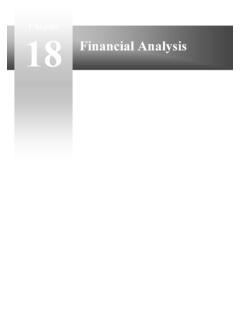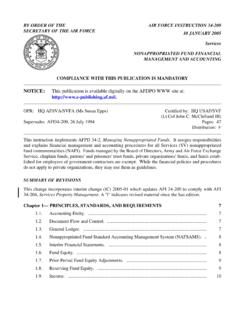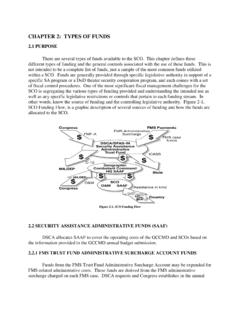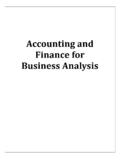Transcription of CHAPTER 11 Operations Management - UWI St. Augustine
1 11-1 Inventory ManagementWilliam J. Stevenson Operations Management8thedition11-2 Inventory ManagementCHAPTER11 Inventory ManagementMcGraw-Hill/IrwinOperations Management , Eighth Edition, by William J. StevensonCopyright 2005 by The McGraw-Hill Companies, Inc. All rights ManagementIndependent DemandAB(4)C(2)D(2)E(1)D(3)F(2)Dependent DemandIndependent demand is uncertain. Dependent demand is : a stock or store of goods11-4 Inventory ManagementTypes of InventoriesTypes of inventories Raw materials & purchased parts Partially completed goods called work in progress Finished-goods inventories (manufacturing firms) or merchandise (retail stores)11-5 Inventory ManagementTypes of inventories (ContTypes of inventories (Cont d)d) Replacement parts, tools, & supplies Goods-in-transit to warehouses or customers11-6 Inventory ManagementFunctions of InventoryFunctions of Inventory To meet anticipated demand To smooth production requirements To decouple Operations To protect against stock-outs11-7 Inventory ManagementFunctions of Inventory (ContFunctions of Inventory (Cont d)d)
2 To take advantage of order cycles To help hedge against price increases To permit Operations To take advantage of quantity discounts11-8 Inventory ManagementObjective of Inventory ControlObjective of Inventory Control To achieve satisfactory levels of customer service while keeping inventory costs within reasonable bounds Level of customer service Costs of ordering and carrying inventory11-9 Inventory Management A system to keep track of inventory A reliable forecast of demand Knowledge of lead times Reasonable estimates of Holding costs Ordering costs Shortage costs A classification systemEffective Inventory ManagementEffective Inventory Management11-10 Inventory ManagementInventory Counting SystemsInventory Counting Systems Periodic SystemPhysical count of items made at periodic intervals Perpetual Inventory System System that keeps track of removals from inventory continuously, thus monitoringcurrent levels of each item11-11 Inventory ManagementInventory Counting Systems (ContInventory Counting Systems (Cont d)d) Two-Bin System -Two containers of inventory.
3 Reorder when the first is empty Universal Bar Code -Bar code printed on a label that hasinformation about the item to which it is attached0214800 23208776811-12 Inventory Management Lead time: time interval between ordering and receiving the order Holding (carrying) costs: cost to carry an item in inventory for a length of time, usually a year Ordering costs: costs of ordering and receiving inventory Shortage costs: costs when demand exceeds supplyKey Inventory TermsKey Inventory Terms11-13 Inventory ManagementABC Classification SystemABC Classification SystemClassifying inventory according to some measure of importance and allocating control efforts importantBB-mod. importantCC-least importantFigure $ valueof itemsAABBCCHighLowFewManyNumber of Items11-14 Inventory ManagementCycle CountingCycle Counting A physical count of items in inventory Cycle counting Management How much accuracy is needed?
4 When should cycle counting be performed? Who should do it?11-15 Inventory Management Economic order quantity model Economic production model Quantity discount modelEconomic Order Quantity ModelsEconomic Order Quantity Models11-16 Inventory Management Only one product is involved Annual demand requirements known Demand is even throughout the year Lead time does not vary Each order is received in a single delivery There are no quantity discountsAssumptions of EOQ ModelAssumptions of EOQ Model11-17 Inventory ManagementThe Inventory CycleThe Inventory CycleFigure of Inventory Level Over TimeQuantityon handQReceive orderPlaceorderReceiveorderPlaceorderRec eiveorderLead timeReorderpointUsage rateTime11-18 Inventory ManagementTotal CostTotal
5 CostAnnualcarryingcostAnnualorderingcost Total cost =+Q2 HDQSTC = +11-19 Inventory ManagementCost Minimization GoalCost Minimization GoalOrder Quantity (Q)The Total-Cost Curve is U-ShapedOrdering CostsQO Annual Cost(optimal order quantity)TCQHDQS=+2 Figure Inventory ManagementDeriving the EOQD eriving the EOQU sing calculus, we take the derivative of the total cost function and set the derivative (slope) equal to zero and solve for = 2 DSH = 2( Annual Demand )(Order or Setup Cost )Annual Holding CostOPT11-21 Inventory ManagementMinimum Total CostMinimum Total CostThe total cost curve reaches its minimum where the carrying and ordering costs are = 2 DSH = 2( Annual Demand )(Order or Setup Cost )Annual Holding CostOPT11-22 Inventory Management Production done in batches or lots Capacity to produce a part exceeds the part s usage or demand rate Assumptions of EPQ are similar to EOQ except orders are received incrementally during productionEconomic Production Quantity (EPQ)Economic Production Quantity (EPQ)
6 11-23 Inventory Management Only one item is involved Annual demand is known Usage rate is constant Usage occurs continually Production rate is constant Lead time does not vary No quantity discountsEconomic Production Quantity AssumptionsEconomic Production Quantity Assumptions11-24 Inventory ManagementEconomic Run SizeEconomic Run SizeQDSHppu02= 11-25 Inventory ManagementTotal Costs with Purchasing CostTotal Costs with Purchasing CostAnnualcarryingcostPurchasingcostTC =+Q2 HDQSTC = ++AnnualorderingcostPD+11-26 Inventory ManagementTotal Costs with PDTotal Costs with PDCostEOQTC with PDTC without PDPD0 QuantityAdding Purchasing costdoesn t change EOQF igure Inventory ManagementTotal Cost with Constant Carrying Costs Total Cost with Constant Carrying Costs OCEOQQ uantity Total CostTCaTCcTCbDecreasingPriceCC a,b,cFigure Inventory ManagementWhen to Reorder with EOQ OrderingWhen to Reorder with EOQ Ordering Reorder Point - When the quantity on hand of an item drops to this amount, the item is reordered Safety Stock -Stock that is held in excess of expected demand due to variable demand rate and/or lead time.
7 Service Level -Probability that demand will not exceed supply during lead Inventory ManagementDeterminants of the Reorder PointDeterminants of the Reorder Point The rate of demand The lead time Demand and/or lead time variability Stockout risk (safety stock)11-30 Inventory ManagementSafety StockSafety StockLTTimeExpected demandduring lead timeMaximum probable demandduring lead timeROPQ uantitySafety stockFigure stock reduces risk ofstockout during lead time11-31 Inventory ManagementReorder PointReorder PointROPRisk ofa stockoutService levelProbability ofno stockoutExpecteddemandSafetystock0zQuant ityz-scaleFigure ROP based on a normalDistribution of lead time demand11-32 Inventory Management Orders are placed at fixed time intervals Order quantity for next interval?
8 Suppliers might encourage fixed intervals May require only periodic checks of inventory levels Risk of stockoutFixedFixed--OrderOrder--Interval ModelInterval Model11-33 Inventory Management Tight control of inventory items Items from same supplier may yield savings in: Ordering Packing Shipping costs May be practical when inventories cannot be closely monitoredFixedFixed--Interval BenefitsInterval Benefits11-34 Inventory Management Requires a larger safety stock Increases carrying cost Costs of periodic reviewsFixedFixed--Interval DisadvantagesInterval Disadvantages11-35 Inventory Management Single period model: model for ordering of perishables and other items with limited useful lives Shortage cost: generally the unrealized profits per unit Excess cost.
9 Difference between purchase cost and salvage value of items left over at the end of a periodSingle Period ModelSingle Period Model11-36 Inventory Management Continuous stocking levels Identifies optimal stocking levels Optimal stocking level balances unit shortage and excess cost Discrete stocking levels Service levels are discrete rather than continuous Desired service level is equaled or exceededSingle Period ModelSingle Period Model11-37 Inventory Management Too much inventory Tends to hide problems Easier to live with problems than to eliminate them Costly to maintain Wise strategy Reduce lot sizes Reduce safety stockOperations StrategyOperations Strategy11-38 Inventory ManagementAdditional PowerPoint slides contributed by Geoff Willis, University of Central Oklahoma.
10 CHAPTER1111-39 Inventory ManagementEconomic Production QuantityEconomic Production QuantityInventory LevelUsageUsageProduction& UsageProduction& Usage11-40 Inventory ManagementGortrac Gortrac ManufacturingManufacturingGTS3 Inventory/Assessment/Reduction11-41 Inventory ManagementMaterialsMaterialsPS7 Washburn Guitars







